Back in 1981, I was privileged to contribute to zoological research in a small private nature reserve in the extreme south of Madagascar. Even at that time, there were the beginnings of wildlife tourism, and visitors came brandishing bananas to feed to one of two troops of wild Ring-tailed Lemurs. Tourists loved such close encounters but conservationists observed that these ‘bananaized’ individuals had fewer babies and wondered if females were malnourished through being tempted away from their normally diverse diet of leaves, buds and native fruits.
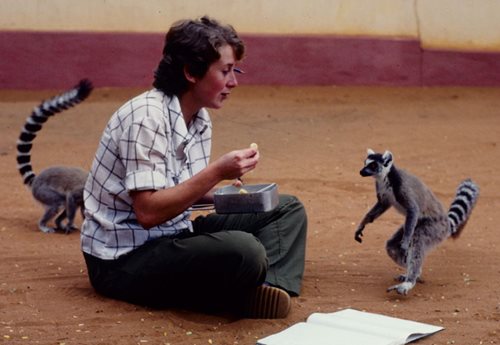 |
| 'Bananaized' Ring-tailed Lemurs disturbing Jane's banana and rice lunch at Berenty in 1981 |
My own researches took me on to the north of the island where – in 1986 – I led an Anglo-Malagasy team documenting the wildlife of the Ankarana Massif, work which eventually contributed to the area achieving National Park status. We also completed the first study of endangered wild Crowned Lemurs. Last autumn, I returned to Madagascar on a mission to see for myself how Crowned Lemurs were faring. I also wanted to meet other lemur species. This quest meant driving 1,100 kilometres, making four ferry-crossings and a couple of outings in pirogues in order to visit six contrasting forest habitats.
On our penultimate forest visit, we drove through rolling savannahs, where the grasslands are punctuated by low outcrops of limestone which mostly only rise a couple of metres above the surrounding grazing grounds. The geology though effectively forms a protective cattle grid where water-storing plants and even full-sized trees can survive. The rock, called tsingy locally, is eroded into spikes and pinnacles that would bacon-slice people or cattle intent on exploiting the succulent plants and special wildlife that live amongst the crevices, coves and crags.
We checked in at the Akiba Lodge within the Andrafiamena Andravakoera protected area and, once the day had started to cool, we walked out over orange-red sandy soils and into the crispy-dry deciduous forest, pausing to admire the occasional chameleon. We tried and failed to catch sight of various animals that we could hear rummaging in the dry yellowing leaflitter.
Finally a slender, long-tailed individual, trotted out onto the path ahead of us and posed nicely for a photograph. He was beautifully camouflaged but with black eye-liner and a striking royal blue patch of skin around his eye, and a purple splodge behind it. This was a chestnut-breasted bird a similar size to a European magpie: a Coquerel’s Coua, representing a whole family of birds that are endemic to Madagascar.
I then tuned into the characteristic alarm shrieks of several Crowned Lemurs, a sound that easily carried a hundred metres or so. What had upset them – a fosa, or an eagle perhaps?
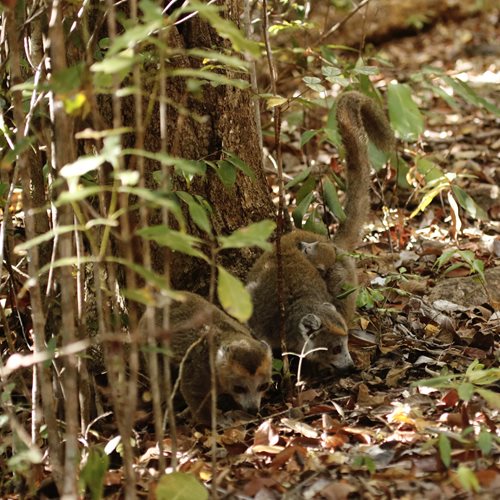 |
| Three Crowned Lemurs - see the baby? |
Further on there were more scufflings and rustlings and then the swishing sound of someone leaping between bushes and shrubs. Ahead on the path there was movement. A male and a female Crowned Lemur were down on the ground, bottoms and tails up, faces down, enthusiastically licking a vertical stick like it was a slender lollypop. They were the size of small cats, weighing a little over a kilogram. We edged closer and focussed the binoculars; they seemed to be slurping up nectar-feeding insects: calorie-rich if not thirst-quenching. Others of the troop arrived and there was a bit of shuffling and tussling for the best position, with the males being nudged out of prime position by the dominant females. We hunkered down to watch, and eventually I think they all managed to enjoy the plunder. Or perhaps they moved off to avoid the large birds circling overhead some of which were raptors.
To me, Crowned Lemurs move like spring-loaded entrepreneurial squirrels scampering along horizonal branches and happily bounding around on the ground, thriving on diet that includes insects and eggs as well as fruits and leaves.
Back at the lodge, we were entertained by day geckos dining on mosquitoes and crickets, and a nightjar using the balcony of the bar / dining area as a perch to hunt from. In the distance again, Crowned Lemurs shrieked.
We headed out after breakfast the next day and downhill into a lush patch of forest in a steep valley. As in visits to other forest areas,
pisseurs (spotters) had gone out ahead of us and soon we met one guide who directed us off-
piste. I caught a glimpse of shiny, jet-black fur and moving leaves and branches as this individual leapt away. I couldn’t see any sign of its troop-mates.
There was a shout from another
pisseur and we were herded back up onto the path again and looped around and into another piece of forest. Once again, the animals were spooked. They didn't seem bothered by all the shouting but perhaps because we had appeared above them. They moved away, jumping up to 10m between trees, shouting their obscene alarm
sniff-fakk before we got much of a view of them through the leaves and low-level scrub. And so it went on, until the
pisseurs found another troop browsing on crispy fresh leaves above a small stream. The sifaka were above us this time. They seemed aloof but relaxed although occasionally they focussed their big amber eyes on us checking on what we were doing.
Tropical jungle is a rich habitat but it is often difficult to see the forest animals. Either leaves and branches obscure them or they are so high up that they are silhouetted against the bright sky. Photography was challenging but we could hunker down to watch. Slowly then they browsed closer and after maybe an hour we were treated to excellent views of most of the troop including one mother – the most nervous – with a babe on her back.
We were in the company of Perrier’s Sifaka, unlike all other sifakas, these are wholly black, except for naked, dark grey faces. They leap off their back legs and enormous feet
, landing feet-first. Their body shape recalls that of a gibbon, although sifaka have long bell-pull tails and shorter arms. Their head and body length is about 45cm with a tail of similar length, and they weigh about five kilograms. They are critically endangered and survive in just two small forest remnants at Andrafiamena and Analamerna. The world population is estimated at around 500 individuals and because they are picky leafeaters they are impossible to keep in zoos so captive breeding isn’t an option.
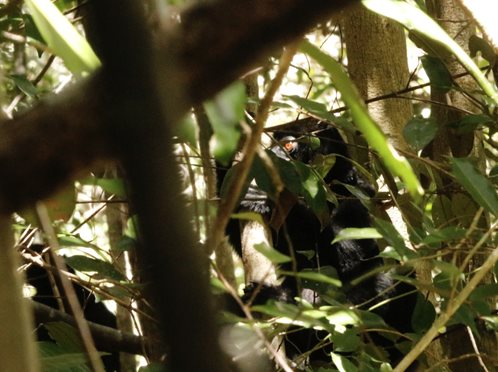 |
| It can be challenging getting good sightings of forest animals |
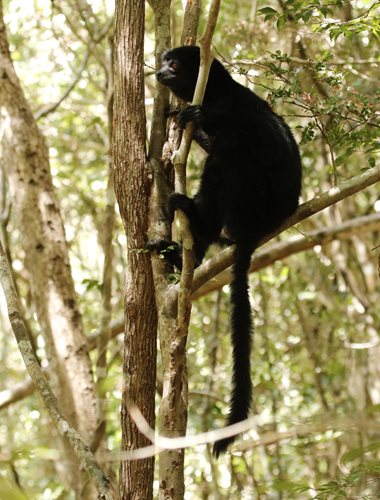 |
| The global population of Perrier's Sifaka amounts to only around 500 individuals |
So here is the conundrum. There is little political interest in conservation in this the fourth poorest nation on earth so the best route to protect attractive but highly endangered species is to encourage tourists to see them, yet what proportion of potential wildlife tourists will sit in the dirt, braving mosquito attack in order to catch a glimpse of a distant animal browsing amongst the underbrush or silhouetted against the sky? Don’t we all hope for a close encounter? Is it acceptable though to habituate wild animals to human approaches? Does that increase their risk of illicit capture or hunting or to catching our diseases? Should tourists expect wild animals to come so close or should we be content with distant sightings or even no encounter at all?
Should we tempt lemurs to approach us as Crowned Lemurs do at the
Campement des Princes at Ankarana and Ring-tailed Lemurs do in the Berenty private reserve in southern Madagascar? Should we be responsible for changing the behaviour of wild animals and perhaps even cause malnutrition by overfeeding them bananas? This, after all, is how many wildlife film-makers capture such wonderful images of exotic species.
Sifaka are too pickily folivorous to be led astray by bananas, but does that mean they’ll never attract many visitors and therefore they and their forest homes are at greater risk than those of cheeky exploitative species?
Conservation of rare animals can be enhanced by film-makers and wildlife tourism but access does need to be properly managed and the issues aren’t as straightforward as they might at first sight seem.
One thing is certain though; there are many exciting efforts led by village co-operatives including replanting native trees and currently tourism is helping protect rare wildlife better than any Malagasy government actions.
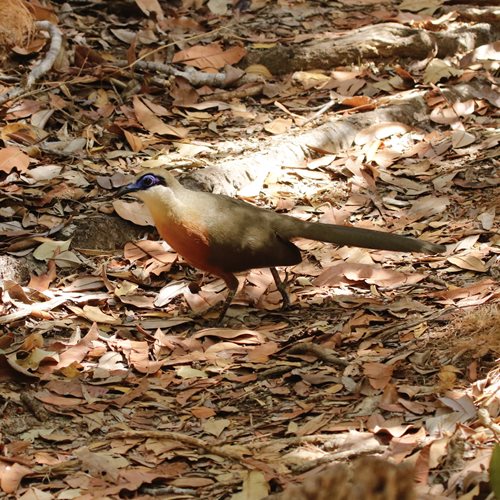 |
| A Coquerel’s Coua, representing a family of birds that are endemic to Madagascar |
Click on
Return to Ankarana to read about the Ankarana Massif and follow other travel blogs